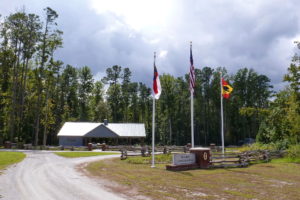
Despite suffering more than 30,000 casualties during the Civil War, North Carolina was not the site of many major battles. But that doesn’t mean the Tar Heel state didn’t see its fair share of fighting. Indeed, the U.S. Navy patrolled the coastline, often providing critical support for invading Union troops. At the same time, guerilla warfare besieged North Carolina’s mountainous regions. The battles at Bentonville and Fort Fisher are among the state’s most famous, but there are lesser-known battles with stories worth telling as well. Here are some to check out.
Battle of New Bern
The Battle of New Bern, fought in spring 1862, was one of several successive amphibious assaults launched by Union Gen. Ambrose Burnside. He had been picking off one Confederate target after another. First came Hatteras Island, then Roanoke Island, and finally Elizabeth City. New Bern was next, crucial not only for its location near the Neuse River but also for its connection along the Atlantic and North Carolina Railroad.
Confederate General Lawrence Branch knew the attack was coming, but there was little he could do to stop it. His troops numbered just 4,000—significantly fewer than the 11,000 Union soldiers that approached. Burnside’s men engaged their Southern foes on the morning of March 14. Their overwhelming force was too much. New Bern was soon evacuated, and the Union had gained an important North Carolina stronghold.
One silver lining did emerge for the Tar Heel state. During the battle, Confederate Colonel Zebulon Vance staged a daring rescue of his men after a bridge was set aflame. His heroism helped him get elected as North Carolina’s Governor later that year.
How to visit: Stroll the trails of New Bern Battlefield Park, 5 miles outside the city of New Bern, taking in near pristine views of fighting positions as well as interpretive panels. The park contains more than 30 acres of the original battlefield, and Ed Bearss dedicated the visitor center in 2009. Guided tours are offered.
Battle of Monroe’s Crossroads
Known more infamously as Kilpatrick’s Shirttail Skedaddle (and also as the Battle of Fayetteville Road), the Battle of Monroe’s Crossroads is an example of a general literally getting caught with his pants down. In the wee hours of the morning on March 10, 1865, Union commander Hugh Judson Kilpatrick led his troops into Hoke County, as they marched on to Fayetteville. With his men in need of rest, he ordered them to set up camp. Meanwhile, Kilpatrick, a recent widower, took up residence with a mistress in a cabin near a farmhouse owned by Charles Monroe.
When Confederate troops learned of the Union Army’s position, they staged a sneak attack that caught Kilpatrick and his men by complete surprise. Dressed in only his nightshirt, Kilpatrick retreated to a swamp, where he began to organize his unit’s defense. Fortunately for him, the Confederate soldiers were so starved that many chose to raid the camp of its food supplies rather than wage their assault. A lull in fighting allowed time for Union reinforcements to arrive, and the battle ended soon after.
Kilpatrick — nicknamed “KilCavalry” for his use of unnecessarily dangerous war tactics — was only emboldened by his brush with an untimely and unseemly demise. A month later, he was part of the surrender negotiations, alongside Maj. Gen. William T. Sherman at Bennett Place in North Carolina.
How to Visit: A historical marker and obelisk-style monument have been placed where it all happened—though it’s in a restricted area of Fort Bragg and permission is required to enter. The monument was placed on the battlefield’s highest ground, near a mass grave where both Confederate and Union soldiers were buried. Call the Fort Bragg Cultural Resources office during office hours (910-396-6680) for further info.
Battle of Waynesville
William Holland Thomas stands out in North Carolina history for many reasons. A State Senator for 12 years from 1848 to 1860, he was also the Principal Chief of the Eastern Band of Cherokee Indians, the only white man to serve in this capacity. During the Civil War, he formed “Thomas’s Legion,” a squad of Native Americans and mountaineers that fought for the Confederate Army. In spring 1865, they advanced on Union troops in Waynesville, just east of the Mississippi River.
Outnumbered and out-gunned, Thomas had a brilliant idea. Ordering his men to build campfires all over the mountainside bordering the Union garrison, he fooled his enemy into thinking they were surrounded. Cherokee soldiers, meanwhile, called out in the dark night at the top of their lungs. The following morning, on May 6, Thomas led his men into the camp with a flag of truce and demanded the Union troops surrender. They did, and hostilities ended.
Three days later, Thomas learned of General Robert E. Lee’s surrender. The war was over, the last shots fired by members of Thomas’s Legion.
How to Visit: There are no remaining physical sites that commemorate this battle, but you’ll find several signs sprinkled throughout the town of Waynesville and in the vicinity that relate its story. Start off at Waynesville’s town hall, at 16 S. Main Street, where a historical marker describes the battle. A battle house stood on N. Main Street near Church Street in what is now Sulphur Springs Park; this is where the Union commander requested a meeting to discuss his surrender. You’ll find more historical signs describing the events. The last shot east of the Mississippi was fired along Sulphur Springs Road near Fifth Street in Waynesville, where a monument marks the event. Stop by the Haywood Visitor Center in Waynesville or Maggie Valley for a Civil War trail map.
